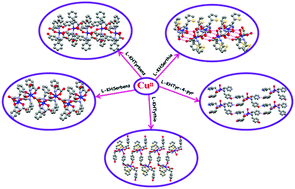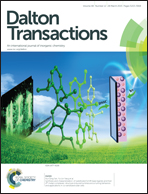Controlling the self-assembly of homochiral coordination architectures of CuII by substitution in amino acid based ligands: synthesis, crystal structures and physicochemical properties†
Abstract
Through the strategic design of ligands based on amino acids, structural diversity in chiral coordination architectures of CuII is demonstrated with six new examples: {[Cu(L-HTyrbenz)2]·CH3OH·H2O}n (1), {[Cu(L-HSerbenz)2]·3H2O}n (2), {[Cu(L-HTyrthio)2]·H2O}n (3), [Cu(L-HTyr4-pyr)2(H2O)]·2H2O (4), [Cu(L-HSerthio)2(H2O)] (5), and [Cu(L-Phethio)2(H2O)]·3H2O (6) [where L-H2Tyrbenz = L-N-(benzyl)-tyrosine, L-H2Serbenz = L-N-(benzyl)-serine, L-H2Tyrthio = L-N-(methyl-2-thiophenyl)-tyrosine, L-H2Tyr4-pyr = L-N-(methyl-4-pyridyl)-tyrosine, L-H2Serthio = L-N-(methyl-2-thiophenyl)-serine and L-HPhethio = L-N-(methyl-2-thiophenyl)-phenylalanine]. For these 1 : 2 metal–ligand complexes, the availability of a donor atom (either from the phenolic OH group or the carboxylate group of one of the ligands) for bridging between the CuII centers results in the formation of coordination polymers (1–3), while no such availability allows a water molecule to occupy the fifth site around the CuII center to generate hydrogen bonded supramolecular assemblies (4–6). In 1, a coordination polymer is formed via a syn–anti bridging carboxylate, and the phenolic group has no role in its formation. To further emphasize this point, L-tyrosine in 1 is replaced with L-serine to form 2, in which an anti–anti bridging by the carboxylate group is observed. On the other hand, the formation of {[Cu(L-HTyrthio)2]·H2O}n (3) results from the growth of a spiral polymer via the unique phenolic bridging with a distance of 10.806(9) Å between two CuII centers. On changing from the L-H2Tyrbenz ligand to the L-H2Tyr4-pyr ligand (1vs.4), the strong hydrogen bonding of the pyridyl nitrogen with the phenolic group does not allow the latter to bind to CuII. Similarly, on changing from L-H2Tyrthio to L-H2Serthio (3vs.5), the length of the –CH2OH group in the latter is much less than the distance between the two CuII centers, therefore this group cannot occupy the fifth site and thus a water molecule is coordinated. This is further confirmed by reacting 5 with 2 eq. of L-H2Tyrthio in methanol to form 3, while the reverse is not possible. All these compounds are characterized by a number of analytical methods, such as elemental analysis, FTIR, UV-Vis and circular dichroism spectroscopy, polarimetry, powder and single crystal X-ray diffraction and thermogravimetric analysis. Photoluminescence properties of all ligands containing the L-tyrosine group and their metal complexes (1, 3 and 4) are compared in solution at room temperature.


 Please wait while we load your content...
Please wait while we load your content...